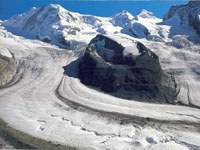Publications
Slip rate variations on normal faults during glacial-interglacial changes in surface loads

Image caption:
Die meisten Alpengletscher befinden sich in einem Rückzugsstadium. © www.oekologische-forschung.de
| Year of publication | 2005 |
|---|---|
| Author(s) | Ralf Hetzel |
| Co-authors | Dr. Andrea Hampel |
| Place of publication | Münster (D) / Bern(CH) |
| Number of pages | 5 |
| Language | en |
| Journal | Nature |
| Page(s) | 5 |
| Magazine No. | 435 |
| Publication type | Journal article |
According to the results of research carried out by the Universities of Münster/D and Berne/CH, the advance and retreat of glaciers and lakes can trigger earthquakes. The research teams studied changes to the glaciated area during the last Ice Age and related the results to palaeo-seismological data. They found that increases and decreases in the loads acting on the Earth's crust can encourage or delay the occurrence of earthquakes.
The research also shows that increased seismic activity develops some one thousand years after the unloading effect on the Earth's crust and can continue for about 10 000 years. This is particularly evident in the case of the Wasatch Fault in the USA. There the crust of the Earth was covered by huge saline lakes and glaciers at the height of the last great Ice Age 20 000 years ago. According to the authors of the report, the disappearance of the lakes and glacial retreat explain the rise in seismic activity in that region.
The research also shows that increased seismic activity develops some one thousand years after the unloading effect on the Earth's crust and can continue for about 10 000 years. This is particularly evident in the case of the Wasatch Fault in the USA. There the crust of the Earth was covered by huge saline lakes and glaciers at the height of the last great Ice Age 20 000 years ago. According to the authors of the report, the disappearance of the lakes and glacial retreat explain the rise in seismic activity in that region.

